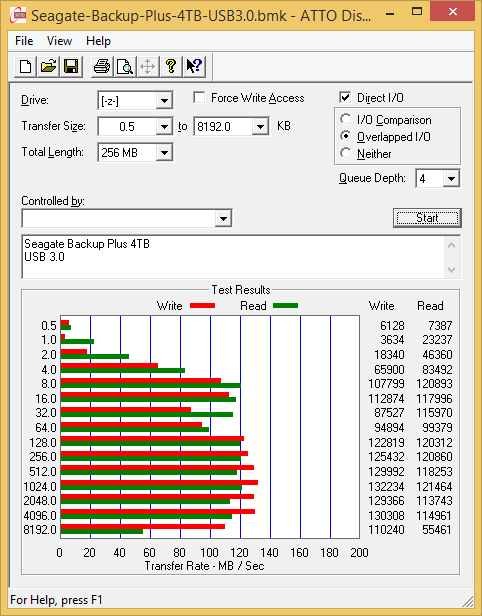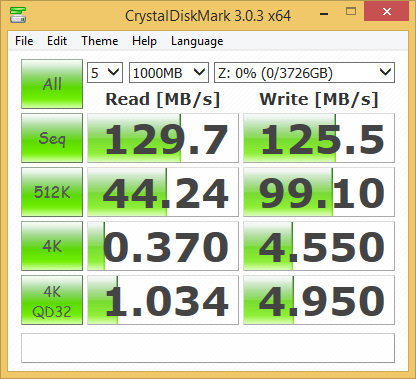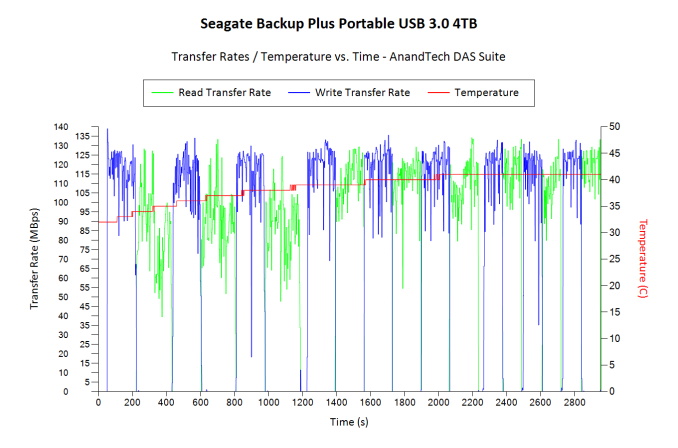Seagate Backup Plus Portable 4TB USB 3.0 Drive Review
by Ganesh T S on August 4, 2015 8:00 AM ESTDAS Benchmarks
The Backup Plus Portable 4TB drive came pre-formatted in NTFS. The root folder also had setup files that opened up the default browser for registering the device / downloading the value-add software (Lyve / Seagate Dashboard). Mac users can also download a NTFS driver for their system, making the unit truly portable across multiple operating systems.
In order to evaluate the DAS aspect of the Backup Plus Portable, we utilized the testbed outlined in the table below to test the performance. One of the USB 3.0 ports hanging off the PCH was used to connect the unit.
| AnandTech DAS Testbed Configuration | |
| Motherboard | Asus Z97-PRO Wi-Fi ac ATX |
| CPU | Intel Core i7-4790 |
| Memory | Corsair Vengeance Pro CMY32GX3M4A2133C11 32 GB (4x 8GB) DDR3-2133 @ 11-11-11-27 |
| OS Drive | Seagate 600 Pro 400 GB |
| Optical Drive | Asus BW-16D1HT 16x Blu-ray Write (w/ M-Disc Support) |
| Add-on Card | Asus Thunderbolt EX II |
| Chassis | Corsair Air 540 |
| PSU | Corsair AX760i 760 W |
| OS | Windows 8.1 Pro |
| Thanks to Asus and Corsair for the build components | |
The full details of the reasoning behind choosing the above build components can be found here.
Our testing methodology for DAS units takes into consideration the usual use-case for such devices. The most common usage scenario is transfer of large amounts of photos and videos to and from the unit. The minor usage scenario is importing files directly off the DAS into a multimedia editing program such as Adobe Photoshop. Prior to taking a look at the real-life benchmarks, we first check what ATTO and CrystalDiskMark have to report for the Backup Plus Portable 4TB drive.
In order to tackle the first real-life use-case, we created three test folders with the following characteristics:
- Photos: 15.6 GB collection of 4320 photos (RAW as well as JPEGs) in 61 sub-folders
- Videos: 16.1 GB collection of 244 videos (MP4 as well as MOVs) in 6 sub-folders
- BR: 10.7 GB Blu-ray folder structure of the IDT Benchmark Blu-ray (the same that we use in our robocopy tests for NAS systems)
| Seagate Backup Plus Portable 4TB robocopy Benchmarks (MBps) | ||
| Write Bandwidth | Read Bandwidth | |
| Photos | 94.57 | 78.18 |
| Videos | 99.02 | 97.74 |
| Blu-ray Folder | 93.36 | 99.64 |
The above benchmark run was also instrumented to record the drive temperature as well as instantaneous transfer rates during the process. The internal disk temperature was only slightly more than 40 C even after more than 127 GB of writes and 127 GB of reads continuously.
For the second use-case, we take advantage of PC Mark 8's storage bench. The storage workload involves games as well as multimedia editing applications. The command line version allows us to cherry-pick storage traces to run on a target drive. We chose the following traces.
- Adobe Photoshop (Light)
- Adobe Photoshop (Heavy)
- Adobe After Effects
- Adobe Illustrator
Usually, PC Mark 8 reports time to complete the trace, but the detailed log report has the read and write bandwidth figures which we present in our performance graphs. Note that the bandwidth number reported in the results don't involve idle time compression. Results might appear low, but that is part of the workload characteristic. This is not the intended use-case for portable hard drives, but the results are just presented here for the sake of completeness
| Seagate Backup Plus Portable 4TB PCMark8 Storage Benchmarks (MBps) | ||
| Write Bandwidth | Read Bandwidth | |
| Adobe Photoshop (Light) | 91.07 | 4.17 |
| Adobe Photoshop (Heavy) | 124.95 | 5.37 |
| Adobe After Effects | 82.20 | 4.18 |
| Adobe Illustrator | 141.41 | 4.08 |
In the next section, we will take a look at the value-add features and provide some concluding remarks.













47 Comments
View All Comments
Jurgen_modeling - Tuesday, August 4, 2015 - link
Does anyone know the power consumption of this drive?I have a Seagate portable 2.5inch 3TB USB3 drive which did not like my Surface Pro 3. When directly hooked up to the Surface Pro 3, the harddisk made scratching noises and could not boot properly. When I hooked up the Seagate 3TB drive to an external USB-based docking station, everything was fine. Other than power draw, I have no idea what else could have caused this issue. I suppose power draw on the 4TB to be similar or worse than on the 3TB drive.
hlmcompany - Tuesday, August 4, 2015 - link
Jurgen, I do not know the power availability specific to a Surface Pro 3 for USB. However, portable hosts, like the SP3, do vary the power state for various devices, including USB ports. The max specified by the USB 3.0 standard is 900 mA, while the minimum is 150 mA.aoshiryaev - Tuesday, August 4, 2015 - link
The speeds reported are low! I have a 1tb USB 3 Transcend drive that reports 200MB seq read/write. Is it possible speed is diminished by capacity somehow?MrSpadge - Tuesday, August 4, 2015 - link
To reach 200 MB/s with an HDD it must be a 3.5" 7.2k rpm model with 1 TB platters, being measured at the beginning of the drive (fastest section). This is a 2.5" drive (slower) at 5.4k rpm (slower).fokka - Tuesday, August 4, 2015 - link
this. a portable 2.5" 1tb drive won't reach anywhere near 200MB/s. half of that if you're lucky. higher values might be due to the cache or some measuring artefacts like you often see in windows.Notmyusualid - Wednesday, December 30, 2015 - link
No, its possible you got your numbers wrong my friend.stevenrix - Tuesday, August 4, 2015 - link
I own this drive, it is very fast if you want to write big files, a big of 1 gb can be transferred in 4 or 5 seconds which isn't bad for a 2.5 inch drive. With tiny files it's a nightmare.For the warranty, I had to send an email to Seagate because it was written "2 years of warranty" in french and "3 years of warranty" in english on the box. It turned out that this drive would be under warranty for 3.5 years.
So far I am satisfied with this drive, I hope this unit won't fail in the next couple of years.
Samus - Tuesday, August 4, 2015 - link
Ganesh, can you disassemble the drive case and take a photo for us?Also, can you take another CDI screen shot after a few hours of use. I'm curious where the load/unload cycle count (APM) value sits with this drive. My guess is its at 64, but I can do some math from the SMART values to determine how aggressive the power saving is set...helping determine the drives lifespan.
ummduh - Monday, August 10, 2015 - link
Have to second this. Does the internal drive use a standard SATA connector?Sort of shocked no one took the case off for a look-see.
Per Hansson - Friday, August 21, 2015 - link
Me to, I would really like to know if it's using a SATA connector or if it's USB direct.